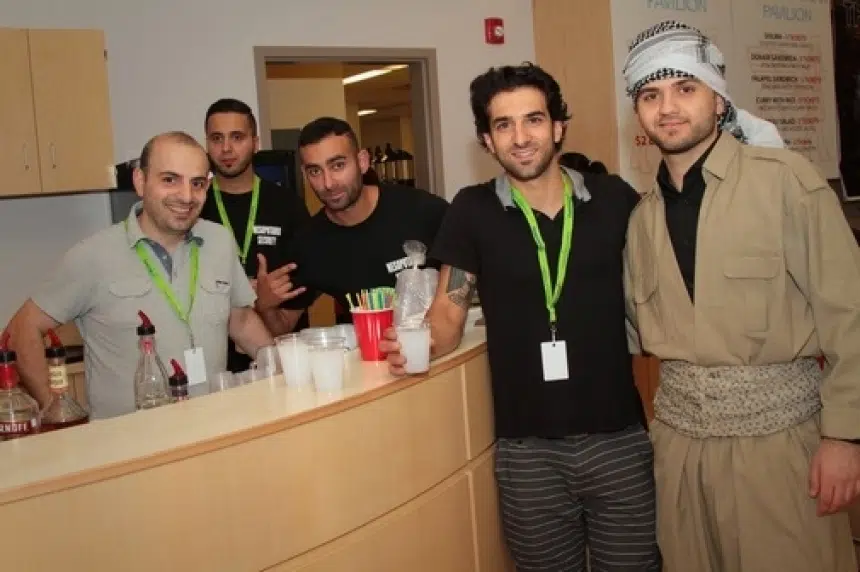Skål, Leutenachen, Sa’heh tokh.
No matter how it’s said, there’s plenty of reasons to cheers at the Saskatoon FolkFest.
Boozy beverages from across the globe have made their way to the three-day cultural festival, and unique drinks are flowing in some of the more unlikely places.
Despite all the drinks being imported from their native countries, none may be more well traveled than Norway’s Akvavit. While still in the cask, the potato-based alcohol is shipped from Norway to Australia and back again before being bottled. The pavilion’s brand, Aquavit, for example, went across the Atlantic Ocean, through the Panama Canal, across the Pacific Ocean to Australia, through South Asia and back.
On the back of each bottle’s label, drinkers can find out what ship their bottle was on and the two dates it crossed the equator.
The tradition dates back more than a century, when returning clipper crews found the Akvavit on board improved during their trip. The boat’s constant movement and the changing heat and humidity helped draw out the flavours from the caraway seed and other spices and herbs inside the casks.
The Akvavit is then served chilled at special occasions like Christmas along with traditional dishes like Lutefisk, pickled herring, and Krumkake for dessert.
“It’s a very deep flavour and it’s not really too sour but some people will find it very strong,” Norwegian pavilion ambassador Jerry Opdahl said with a laugh. “It’s really good, I really like it, but there’s got to be a limit.”

Akvavit is a traditional Norwegian drink. Lasia Kretzel/News Talk Radio
While some drinks traveled the world, others don’t even leave the home.
Ethiopia debuted its pavilion this year and brought along a local beer. The St. George Beer comes from one of the country’s oldest breweries and features the legend of St. George killing a dragon on the label.
Despite beer’s popularity in Ethiopia, pavilion manager Tadele Gebreyohannes said most people don’t buy it in the store. Because most of the country’s population lives in rural settings and may not have access to or the money to buy beer, he said many locals brew their own in their homes.
“In the cities, people can afford to buy bottled beer, but mostly we have local home made beer in every house, and it’s different,” Gebreyohannes said.
He said they chose to bring a company beer because they wanted to introduce Canadians to Ethiopian breweries and create a market for the country’s beer in Canada.
St. George Beer comes from one of the oldest breweries in Ethiopia. Lasia Kretzel/News Talk Radio
As Saskatoon residents get to know international drinks, they’re also finding liquor in unexpected countries and regions.
Unlike their deserts, the regions that make up the Mesopotamian pavilion are far from dry.
“They don’t call them spirits for no reason, because we sure are full of them,” pavilion manager Giovani Yousif said.
The “land between rivers” spans the Tigris-Euphrates river system and includes sections of modern day Syria, Iraq, Kuwait, Turkey and Iran.
However many of Saskatoon’s Mesopotamian community are Christian and do not practice the region’s more well-know Islamic tradition of prohibition.
“Let’s just say that you start and end every good night with a drink and we know that better than anyone else,” Yousif said.
The pavilion features a Turkish drink called Arak. The anise-base liqueur is known as the “Mesopotamian ouzo” according to Yousif because of its black licorice flavour. The clear alcohol is taken as a shot or mixed with water and ice whereupon the solution turns a translucent white.
Yousif said they wanted to include alcohol culture into their pavilion to bring people and communities together despite political, social and cultural differences.
“Let’s tie one and kind of forget about that for a minute and enjoy ourselves,” he said.
All the drinks are available at their respective FolkFest pavilions between 5 p.m. and midnight Saturday.
Dancers perform at the Mesopotamian pavilion. Lasia Kretzel/News Talk Radio
Follow on Twitter: @lkretzel







